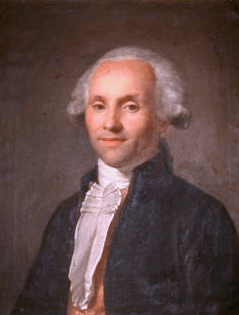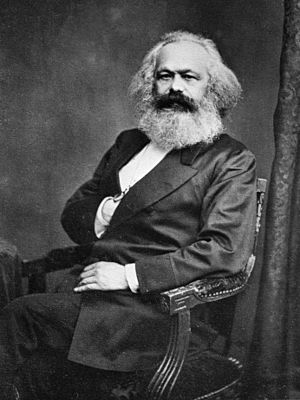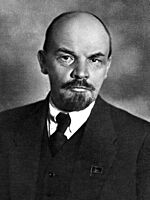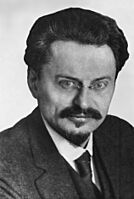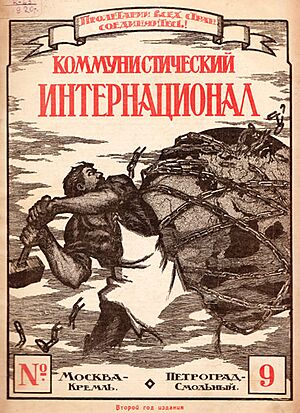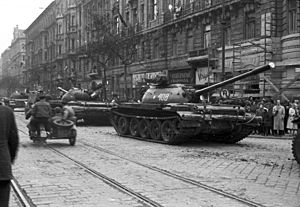History of communism facts for kids
The history of communism looks at many different ideas and political movements. They all share the main belief that wealth, businesses, and property should be owned by everyone together. Most modern types of communism are based on Marxism. This was a theory created by Karl Marx and Friedrich Engels in the 1800s. Marxism became very popular in Europe. In the late 1800s, its strong supporters tried to start revolutions, but they didn't succeed. At the same time, many communist parties formed that didn't want armed revolution. But they still believed in the Marxist idea of collective property and a classless society.
Marx's theory suggested that industrial countries were the best places for big changes (either peacefully or by force). However, communism mostly succeeded in poor countries like the Russian Empire and China. In 1917, the Bolshevik Party took power during the Russian Revolution. In 1922, they created the Soviet Union, which was the world's first country to call itself a socialist state. The Bolsheviks strongly believed in spreading their ideas worldwide. They saw their fight as a global one, not just local. This had a huge impact on how communism spread in the 20th century. The Soviet Union helped set up new Marxist–Leninist governments in Central and Eastern Europe after World War II. They also supported others in the Americas, Asia, and Africa. A key group for this was the Communist International, also called the Comintern. It was formed to help communist parties around the world and encourage revolutions. This was a major reason for problems during the Cold War. The United States and its allies saw the spread of communism as the Soviet Union expanding its power through others.
By 1985, about one-third of the world's people lived under some form of Marxist–Leninist government. However, there was a lot of debate among communist thinkers about whether these countries were truly Marxist. Many basic parts of the Marxist system were changed by these countries. Communism quickly declined in the late 1980s and early 1990s. This included the dissolution of the Soviet Union in 1991. Several other Marxist–Leninist states also gave up or ended the ideology. Later historians have given different reasons for this decline. Some say Marxist-Leninist governments didn't live up to the idea of a communist society. Others say they became too authoritarian, had too much bureaucracy, or had inefficient economies. In the 21st century, only a few Marxist–Leninist states remain: China, Cuba, Laos, North Korea, and Vietnam. Except for North Korea, all these countries have started allowing more economic competition. But they still keep one-party rule.
Contents
What is Communism?
Communism is a set of ideas and movements that believe in common ownership. This means that wealth, businesses, and property should belong to everyone, not just a few people. The goal is often a classless society where everyone is equal.
Early Ideas of Communism
Many groups throughout history have had ideas similar to communism.
Ancient Times
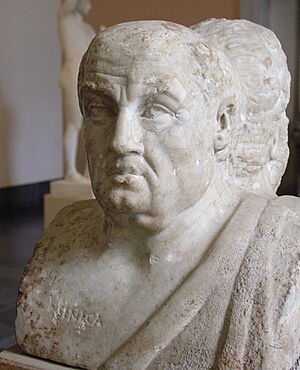
Karl Marx and other early communist thinkers believed that hunter-gatherer societies were very equal. They called their way of life "primitive communism". One of the first to write about this was the Roman philosopher Seneca the Younger. He said, "How happy was the primitive age when the bounties of nature lay in common." He thought these early societies were the richest because there was no poverty. Other ancient writers like Diodorus Siculus, Virgil, and Ovid also believed in a time when people shared everything. Early Christian leaders also thought human society had fallen from an equal past.
In Ancient Greece, around 400 BC, ideas like communism were so common that they were made fun of in plays. The writer Aristophanes wrote a comedy where women take over the government. They get rid of all private property and make sharing women and raising children together a rule. Later, in Plato's Republic, Socrates said that in a perfect state, the leaders shouldn't own private property. He even suggested sharing children and wives. He believed this would stop fights and make everyone feel united. Around AD 500 in Iran, a religious leader named Mazdak started a movement that preached religious communism. The king at first supported him, but later stopped the movement and had Mazdak killed.
Christian Beliefs
Early Christians believed in sharing based on the New Testament. For example, the Book of Acts says that all believers shared their belongings. They gave things to people who needed them. A Jewish group called the Essenes also believed in social and material equality. Even though these practices became less common, the idea of sharing property continued in Christian traditions like monasticism.
From the Middle Ages to early modern times in Europe, some Christian groups adopted ideas of sharing property. The Waldensians in the 1100s shared their property. But the Catholic Church persecuted them. Later, in the 1200s, groups like the Franciscans questioned private property. Even the Pope had to defend private property in a special order. Another group, the Beghards, started in the Low Countries. They gave up private property and lived together, working as artisans. They spread to other parts of Europe but were also condemned by the Catholic Church.
Around 1300, a group in Italy called the Apostolic Brethren was led by Fra Dolcino. His group, the Dulcinians, wanted to end feudalism and share all property. In the 1300s, the English thinker John Wycliffe also spoke of an ideal Christian state with shared ownership. The revolutionary priest John Ball, who was part of the Peasants' Revolt, supposedly said that England wouldn't be well until "all goods are held in common."
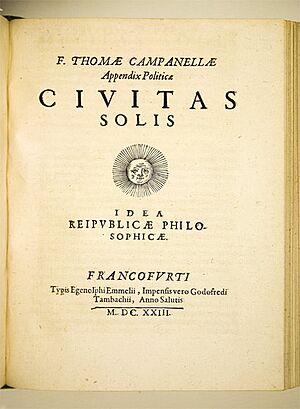
In Bohemia in the 1400s, a radical group called the Taborites tried to create a "community of goods." They said, "there is no mine or thine but all is held in common." But this idea was quickly dropped. Later, during the Protestant Reformation in the 1500s, some Anabaptists also supported sharing goods. The Hutterites in Moravia and the Münster Anabaptists were notable groups. In the mid-1600s, during the English Civil War, groups like the Diggers wanted to share wealth and create a society without property.
Writers in Europe also started writing about perfect communist societies in utopian stories. Thomas More wrote Utopia (1516). In his story, there is an island without money or private property, where "everything is under state control." More called his ideal community "utopia," which means "nowhere" in Latin. This showed he didn't think such a society was possible. Tommaso Campanella's 1601 book The City of the Sun also described a society where everything was shared. In his utopia, people were educated, worked only four hours a day, and had no private property.
Enlightenment Ideas
During the Age of Enlightenment in 18th-century France, some writers started criticizing private property. They even called for it to be abolished. One of the first non-religious ideas for a communist society came from the French priest Jean Meslier in his book Testament (1729). Another French philosopher, the Abbé de Mably, wrote that owning land was the cause of all problems. He thought that wealth inequality led to social ruin. He believed only a society based on shared ownership could fix it. However, he also thought that trying to create true equality would be too costly.
Another French thinker, Étienne-Gabriel Morelly, also argued that private property caused all bad things in society. He developed basic rules for a communist society: no private property, everyone has the right to live and work, and everyone must work for the common good. The French philosopher Jean Jacques Rousseau wrote in The Social Contract (1762) about a political system based on the people's power, not kings. In his Discourse on Inequality (1755), he said that private property led to "crimes, wars, murders, and suffering."
In 1785, the French writer Restif de la Bretonne reviewed a book by Victor d'Hupay. This book described a plan for a community in Marseille where private property was banned. Restif noted that d'Hupay had called himself a "communist" in 1782. This was the first time the word "communist" was recorded. Restif himself wrote many novels about getting rid of private property. He used the term "community of goods" in 1783 and then "communism" in 1793.
These French ideas were important during the French Revolution of 1789. Many who opposed the king, especially the Jacobins, supported sharing wealth equally. This included Jean-Paul Marat and Gracchus Babeuf. Babeuf was part of the Conspiracy of the Equals in 1796. This group wanted to create a revolutionary government based on shared ownership and equality. Babeuf was influenced by Morelly's book The Code of Nature. Another revolutionary, Sylvain Maréchal, who joined Babeuf's group, wrote in his Manifesto of the Equals (1796): "we aim at something more sublime and more just, the COMMON GOOD or the COMMUNITY OF GOODS." He also said the French Revolution was just the start of a much bigger revolution. Babeuf's plan was discovered, and he was arrested and executed. Because of his ideas, Babeuf is sometimes called the first revolutionary communist.
After the French Revolution
One of Babeuf's partners, Philippe Buonarroti, survived and later wrote an important book called Babeuf's Conspiracy for Equality (1828). This book shared Babeuf's ideas. Buonarroti believed that "burdens, productions, and advantages ought to be equally divided." He thought this would lead to "the greatest possible happiness of all." His writings led to a new interest in Babeuf's ideas in France, called Neo-Babouvism. This idea suggested that a small group of "wise and courageous" revolutionaries would be needed to guide the people and create a new equal society.
By the 1830s and 1840s, the ideas of communism and socialism became very popular in French revolutionary groups. This was thanks to writers like Pierre Leroux and Théodore Dézamy. They criticized the rich and the idea of individualism. This led many thinkers to reject laissez-faire capitalism. Leroux wrote in 1832 that focusing only on individualism would lead to the poor being exploited. He said that private ownership of businesses allowed the rich to take advantage of the working class. Dézamy wrote in 1842 that a "complete and unrestricted society of communal property" was needed. In this society, all activities would be controlled from a central point. Marx considered Dézamy one of the first "scientific socialists" because of his detailed analysis of communism. It was around 1840 that supporters of common ownership in France, like Théodore Dézamy, Étienne Cabet, and Jean-Jacques Pillot, started using the word "communism" widely for their beliefs.
A big event that showed how popular communism was becoming in France happened in 1840. Dézamy, Pillot, and Albert Laponneraye organized a pro-communist dinner in Belleville, Paris. This was the "first public showing of the communist party" in France. It was so successful that the French government had to ban future communist dinners. Also in 1840, a group called "Egalitarian Workers" was founded in Paris, following a communist plan. A general strike was called, and its leaders were said to be inspired by communist ideas. In the 1840s, Étienne Cabet had between 100,000 and 200,000 French workers following him. Friedrich Engels saw him as a leader of the French working class.
One of the most important French communists of the 1840s was Auguste Blanqui. He believed that violent revolution was needed to overthrow the rich-controlled government. Blanqui thought a small, secret group could lead a revolution and then set up a "dictatorship of the proletariat" (rule by the working class). Dézamy disagreed with a dictatorship. He thought the main goal should be to unite the working class through education and spreading ideas.
The ideas of these French writers, many of whom now called themselves communists, inspired new communist groups. These included the League of the Just, founded in Paris in 1836 by German Christian communists Wilhelm Weitling and Karl Schapper. Another group, the Communist Correspondence Committee, was formed in Brussels in 1846 by Karl Marx and Friedrich Engels. The two groups joined in 1847 to form the Communist League. Schapper led it and asked Marx and Engels to write a manifesto (a public declaration) explaining the new party's principles.
The Ideas of Karl Marx
Karl Marx and His Theories
Communism is the riddle of history solved, and it knows itself to be this solution.
—Karl Marx, 1844
In the 1840s, the German philosopher Karl Marx lived in England after fleeing from Prussia. He started publishing books that explained his theories for a type of communism called Marxism. Marx was helped financially by another German, Friedrich Engels (1820–1895). Engels also fled from German authorities. Marx and Engels were influenced by earlier socialists and French Revolution figures. They were also influenced by economists like David Ricardo and philosophers like Georg Wilhelm Friedrich Hegel. Engels often met Marx at Chetham's Library in Manchester, England. There, Engels shared his experiences of industrial Manchester, which he wrote about in The Condition of the Working Class in England. This book showed the struggles of the working class.
Marx said that "the history of all hitherto existing society is the history of class struggles". He believed this struggle was happening between the bourgeoisie (the rich upper and middle classes who controlled society) and the proletariat (the working class who did all the work but had no political power). He thought human society moved through stages: from primitive communism to slavery, feudalism, and then capitalism. He believed capitalism would eventually be replaced by communism. For Marx, communism was something that would happen, but it was also something to work towards.
Marx founded the Communist Correspondence Committee in 1846. This group helped communists, socialists, and other leftists across Europe stay in touch despite political repression. In 1848, he published The Communist Manifesto, which became one of the most important communist texts ever. He then started writing a large book called Capital: Critique of Political Economy, which looked at and criticized the capitalist economy. The first part was published in 1869. Marx and Engels didn't just write about communism. They also actively supported revolutionary actions that they hoped would lead to communist governments in Europe. They helped create the International Workingmen's Association, later known as the First International, to unite different communist and socialist groups. Marx was elected to its main council.
Marx summed up his system with the phrase, "From each according to his ability, to each according to his needs." This idea was also used by earlier socialist activists like August Becker and Louis Blanc.
How Marxism Developed
In the late 1800s, various left-wing groups in Europe continued to fight against the many authoritarian governments in power. In France, socialists set up a government called the Paris Commune after the fall of Napoleon III in 1871. But they were quickly overthrown, and many members were killed. Meanwhile, Karl Marx and Friedrich Engels joined the German Social-Democratic Party, created in 1875. This party was banned in 1879 by the German government, led by Chancellor Otto von Bismarck. He saw it as a threat because of its revolutionary nature and growing support. In 1890, the party became legal again. By this time, it had fully adopted Marxist ideas. It later won a fifth of the votes in German elections, and some of its leaders became well-known.
Marxism became popular not only in Germany but also in Hungary, the Habsburg monarchy, and the Netherlands. However, it didn't succeed as much in other European nations like the United Kingdom. Still, the new political idea gained enough support that an organization called the Second International was founded to unite Marxist groups worldwide.
As Marxism grew, it also faced criticism from other European thinkers, including fellow socialists. For example, the Russian anarchist Mikhail Bakunin criticized Marx's idea that the state would eventually disappear under a Marxist government. Bakunin believed the state would instead become more powerful and authoritarian. Other sociologists, like the German Max Weber, also disagreed with some of Marx's ideas about society. Some Marxists tried to change their ideas to fit these criticisms and the changing nature of capitalism. Eduard Bernstein suggested that Marxists should focus on legal challenges against governments to improve workers' lives, rather than just violent revolution. Other Marxists, like Karl Kautsky, Rosa Luxemburg, and Vladimir Lenin, opposed these changes. They stuck to the idea of violently overthrowing the rich-controlled government and setting up a "dictatorship of the proletariat."
Early Communist States (1917–1944)
The Russian Revolution and the Soviet Union
At the start of the 1900s, the Russian Empire was ruled by Tsar Nicholas II. Millions of people, mostly farmers, lived in extreme poverty. Historian Robert Service said that "poverty and oppression constituted the best soil for Marxism to grow in." The person who brought Marxist ideas to Russia was Georgi Plekhanov. But the movement was mostly organized by Vladimir Lenin, who had been sent to a prison camp in Siberia by the Tsar for his beliefs. A Marxist group called the Russian Social Democratic Labour Party formed in Russia. It soon split into two main groups: the Bolsheviks led by Lenin, and the Mensheviks led by Julius Martov.
In 1905, there was a revolution against the Tsar. workers' councils, called soviets, were formed in many places. The Tsar had to make democratic changes, like creating an elected government called the Duma.
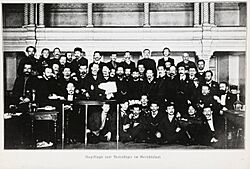
In 1917, with more unrest against the Duma and Russia's involvement in World War I, the Bolsheviks took power in the October Revolution. They started changing the country by taking over industries and taking land from rich landowners to give to peasants. They also pulled out of the war with Germany by signing the Treaty of Brest-Litovsk. This treaty was unpopular because it gave away large areas of land to Germany. Lenin's government also brought in new ideas like education for everyone, healthcare, and equal rights for women. From the beginning, the new government faced resistance from many groups. These included anarchists, social democrats, and forces loyal to the Tsar. This led to the Russian Civil War, which the Bolsheviks won. They then took full control of the country, with power centered in Moscow. In the early 1920s, Lenin started recruiting black workers, saying American political parties weren't doing enough for black civil rights. Some African American activists were interested in communism. In 1922, the Russian Socialist Federative Soviet Republic officially became the Union of Soviet Socialist Republics, or the Soviet Union.
In 1924, Lenin stepped down as leader of the Soviet Union due to poor health and soon died. Joseph Stalin then took control.
Spreading Communism in Europe
In 1919, the Bolshevik government in Russia created an international communist organization called the Communist International, or Comintern. The Comintern was mostly controlled by the Soviet Union. In 1921, the Soviet Union helped an uprising in neighboring Mongolia against Chinese control. They set up a pro-Soviet government, which declared the nation the Mongolian People's Republic in 1924.
The Comintern and other Soviet-backed communist groups soon spread worldwide, especially in Europe, where the Russian Revolution's influence was strong. In Germany, the Spartacist uprising happened in 1919. Armed communists tried to set up a Soviet-style republic, but the government violently stopped the rebellion. German communist leaders Rosa Luxemburg and Karl Liebknecht were killed. A few months later, communists took power in Bavaria, forming the Bavarian Soviet Republic. This was also violently put down.
In Hungary, after their defeat in World War I, a government formed with the Social Democratic Party and the Communist Party. The Hungarian Communist Party led by Béla Kun soon became dominant and made communist changes. But neighboring Romania invaded and overthrew the government within months. In 1921, a communist revolt happened in Kingdom of Italy during factory worker strikes in Turin and Milan. The government quickly stopped it. Other communist rebellions in Germany and Bulgaria in the 1920s were also defeated.
Stalin's Rule
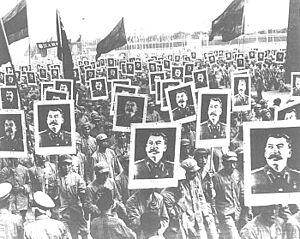
In 1924, Joseph Stalin, a key follower of Lenin, took power in the Soviet Union. Stalin began building a communist society in his own way, creating a type of communism called Marxism–Leninism. He ended some of the capitalist policies that Lenin had allowed. Stalin's policies greatly changed Soviet farming. He modernized it with tractors and other machines. He also forced farmers to join large collective farms and took grains from them. Food was available for factory workers, but farmers who refused to move starved, especially in Kazakhstan and Ukraine. The Communist Party targeted rich peasants called kulaks.
Stalin took control of the Comintern. He made it oppose all leftists who were not Marxist–Leninists, calling them "social fascists." Many communists disagreed, believing the left should unite against the rise of right-wing movements like fascism. In the early 1930s, Stalin changed course. He promoted "popular front" movements, where communist parties would work with socialists and other political groups. A big goal was to get wide support for the Republican side in the Spanish Civil War.
The Great Purge
The Great Purge happened mainly from 1936 to 1938. During this time, Stalin systematically got rid of older leaders from before 1918. He often said they were enemy spies or "enemies of the people." In the Red Army, most generals were executed. Hundreds of thousands of other "enemies of the people" were sent to the gulag, which were labor camps in Siberia where conditions were very harsh.
New information from Soviet archives shows that earlier estimates of those arrested and killed were too high. By 2009, historian Archie Brown reported that about 1.7 million people were arrested in 1937–1938, and half of them were shot.
Spreading Communism After World War II (1945–1957)
As the Cold War began around 1947, the Soviet Union set up new international groups. These included the World Federation of Democratic Youth (for young people), the International Union of Students (for students), and the World Federation of Trade Unions (for workers' unions). These groups helped spread communist ideas.
The World Federation of Trade Unions (WFTU) was created in 1945 to unite workers' unions worldwide. It was based in Prague. Even though it had non-communist unions, the Soviets mostly controlled it. In 1949, British, American, and other non-Communist unions left to form a rival group.
The Soviet Union After World War II
After the war, the Soviet Union had a huge recovery program to rebuild factories, homes, and transportation. Millions of soldiers and civilians also moved. During this time, in the winter of 1946–1947, the Soviet Union had its worst natural famine of the 20th century. There was no real opposition to Stalin, as the NKVD secret police kept sending possible suspects to the gulag.
Relations with the United States and Britain quickly changed from friendly to hostile. They criticized Stalin's control over Eastern Europe and his blockade of Berlin. By 1947, the Cold War had begun. Stalin believed capitalism was weak and would fall apart under pressure. However, he greatly underestimated the West's economic strength. Instead of triumph, he saw the West build alliances to stop Soviet expansion. In early 1950, Stalin approved North Korea's invasion of South Korea, expecting a quick war. He was surprised when the Americans joined and pushed the North Koreans back. Stalin supported China's entry into the Korean War, which pushed the Americans back to the original borders but increased tensions. The United States decided to prepare its economy for a long competition with the Soviets. They built the hydrogen bomb and strengthened the NATO alliance in Western Europe.
After 1945, Stalin's main goal was to make the Soviet Union a superpower and keep his own power. He created a leadership system that was like old Russian rulers, with strong control. Personal loyalty to Stalin was very important. However, Stalin also created powerful committees and promoted younger experts. Even with persecution, Stalin's deputies developed informal ways of working together. These helped create a system of shared rule after he died.
Eastern Europe
The Red Army's military success in Central and Eastern Europe led to communists taking power. In some countries, like Czechoslovakia, people supported socialism and the Communist Party. In others, like Poland or Hungary, the Communist Party and Social Democratic Party were forced to join together. In many cases, people in Central Europe were willing to limit market forces and support social welfare programs. However, the removal of non-communist parties, forced collectivization of farms, and an economic slowdown in 1953 led to deep unrest. This unrest first appeared in Berlin in 1953.
Hungarian Revolution of 1956
The Hungarian Revolution of 1956 was a big challenge to Moscow's control over Eastern Europe. There were general strikes, and independent workers' councils formed. The Social Democratic Party became independent again. Two independent communist parties also formed. For about a week, the main Communist Party was led by people not aligned with the Soviet Union. Two non-communist parties that supported socialism also became independent. This rise of different communist ideas was crushed by a Soviet military invasion with heavy artillery and airstrikes. There were mass arrests, many executions, and the main workers' council was destroyed. Many people fled the country. The Hungarian Revolution caused many people to leave communist parties in English-speaking countries.
Prague Spring of 1968
The Czechoslovak Communist Party started a big reform plan under Alexander Dubček. This plan aimed to limit central control and make the economy more independent from the party. This threatened core communist beliefs. On August 20, 1968, Soviet leader Leonid Brezhnev ordered a huge military invasion by Warsaw Pact forces. This stopped the internal changes. At the same time, the Soviets threatened to act against the British-French-Israeli invasion of Egypt. This led to a breakdown in efforts to reduce tensions (détente) and more intellectuals leaving communist parties in the West.
China's Communist Path
The Great Leap Forward
Mao Zedong and the Chinese Communist Party took power in China in 1949. The Nationalists fled to Taiwan. From 1950 to 1953, China fought a large, undeclared war with the United States, South Korea, and United Nations forces in the Korean War. While it ended in a military tie, it gave Mao a chance to find and remove people in China who seemed to support capitalism. At first, China worked closely with Stalin, who sent technical experts to help with industrialization, similar to the Soviet model of the 1930s. After Stalin's death in 1953, relations with Moscow worsened. Mao thought Stalin's successors had betrayed the communist ideal. Mao accused Soviet leader Nikita Khrushchev of leading a "revisionist group" that had turned against Marxism and Leninism and was preparing to bring back capitalism. By 1960, the two nations were strongly opposed. Both started making alliances with communist supporters around the world, splitting the global movement into two opposing groups.
Mao Zedong and his top aide Deng Xiaoping rejected the Soviet idea of fast city growth. They launched the Great Leap Forward from 1957 to 1961. Their goal was to make China an industrial country very quickly, using peasant villages instead of big cities. Private land ownership ended, and peasants worked on large collective farms. These farms were told to start heavy industry, like steel mills. Factories were built in remote places, even without experts, managers, or good transportation. Industrialization failed, and the main result was a sharp drop in farm output. This led to a huge famine and millions of deaths. The years of the Great Leap Forward actually saw the economy shrink. Economist Dwight Perkins said, "Enormous amounts of investment produced only modest increases in production or none at all. [...] In short, the Great Leap was a very expensive disaster." Deng was put in charge of fixing the economy. He adopted practical policies that the idealistic Mao disliked. For a while, Mao was less visible, but he returned to power and removed Deng and his allies in the Cultural Revolution (1966–1969).
Cold War and Changes in Communism (1958–1979)
Maoism and China's Cultural Revolution
The Cultural Revolution was a big social and political movement in China from 1966 to 1976. Mao's goal was to "purify" communism by removing people he saw as pro-capitalist or traditional. He wanted to enforce his ideas, called Maoist orthodoxy, within the Chinese Communist Party. This movement stopped China politically and hurt the country's economy, culture, and education for years. Millions of people were accused, shamed, lost their power, and were either imprisoned, killed, or sent to work as farm laborers. Mao insisted that these people, whom he called revisionists, be removed through violent class struggle. The movement spread to the military, city workers, and even the Communist Party leadership. It led to widespread fighting between different groups in all parts of society. Among the top leaders, many senior officials were removed for supposedly taking a "capitalist road," especially Liu Shaoqi and Deng Xiaoping. During this time, Mao's personality cult grew enormously. After Mao's death in 1976, the survivors were allowed to return to their positions, and many regained power.
The Cuban Revolution
The Cuban Revolution was a successful armed uprising led by Fidel Castro's 26th of July Movement. It fought against the rule of Cuban dictator Fulgencio Batista. Batista was overthrown on January 1, 1959, and Castro's revolutionary government took over. Castro's government later changed to follow communist ideas, becoming the current Communist Party of Cuba in October 1965. The United States reacted very negatively. This led to a failed invasion attempt in 1961. The Soviets decided to protect their ally by placing nuclear weapons in Cuba in 1962. In the Cuban Missile Crisis, the United States strongly opposed this. There was a serious fear of nuclear war for a few days. But a compromise was reached: Moscow publicly removed its weapons, and the United States secretly removed its weapons from Turkey and promised not to invade Cuba.
Communism in Africa

During the time when African countries were gaining independence from colonial rule, the Soviet Union was very interested. They hoped that creating communist states there would prevent the West from getting their resources. Soviet foreign policy believed that new African governments would like communist ideas. They also thought the Soviets had enough resources to be attractive partners. In the 1970s, the ruling parties of several countries in sub-Saharan Africa officially adopted communism. These included the People's Republic of Benin, the People's Republic of Mozambique, the People's Republic of the Congo, the People's Democratic Republic of Ethiopia, and the People's Republic of Angola. Most of these governments adopted communist ideas in a flexible way, often to justify having strong central power.
Angola was perhaps the only African country that committed to communism for a long time. But its efforts were hurt by war, widespread corruption, and practical issues. A few foreign companies still had a lot of influence, even though the local private businesses were removed and the economy was largely centrally planned. Both Angola and Ethiopia built new communist institutions similar to those in the Soviet Union and Cuba. However, their governments either fell apart after the Soviet Union collapsed (due to civil conflict) or willingly gave up communism for social democracy.
Eurocommunism
An important trend in several Western European countries from the late 1960s to the 1980s was Eurocommunism. It was strongest in Spain, Finland, and especially Italy. It was developed by communist party members who were unhappy with both the Soviet Union and China. They wanted an independent path. They accepted liberal parliamentary democracy, free speech, and, with some conditions, a capitalist market economy. They did not talk about destroying capitalism. Instead, they aimed to win public support and gradually change government systems. In 1978, the Communist Party of Spain changed its slogan from "Marxist–Leninist" to "Marxist, democratic and revolutionary." The movement faded in the 1980s and ended when communism fell in Eastern Europe in 1989.
End of the Eastern Bloc (1980–1992)

People in Eastern Europe started resisting communist governments more strongly with the rise of Solidarity. This was the first non-communist trade union in the Warsaw Pact, formed in People's Republic of Poland in 1980.
In 1985, Mikhail Gorbachev became the leader of the Soviet Union. He started policies of major political reform, including political openness (called glasnost) and restructuring (called perestroika). Gorbachev's policies aimed to remove the authoritarian parts of the state that Stalin had created. He wanted to bring back what he saw as the ideal Leninist state. He kept a one-party system but allowed democratic elections for different candidates within the party. Gorbachev also wanted to improve relations with the West and end the Cold War. He believed the Soviet Union could no longer afford the Cold War. The Soviet Union and the United States, under President George H. W. Bush, worked together to end apartheid in South Africa. They also oversaw the end of South African colonial rule in Namibia.
Meanwhile, the communist states in Eastern Europe weakened politically. This was due to the success of the Polish Solidarity movement and the possibility of Gorbachev-style reforms. In 1989, revolts began across Eastern Europe and China against communist governments. In China, the government refused to talk with student protestors. This led to the Tiananmen Square attacks, which stopped the revolts by force.
The opening of a border gate between Austria and Hungary at the Pan-European Picnic on August 19, 1989, started a peaceful chain reaction. This led to the end of East Germany and the breakup of the Eastern Bloc. It was the largest escape from East Germany since the Berlin Wall was built in 1961. The mass exodus at the Pan-European Picnic, the hesitation of the East German government, and the Soviet Union's decision not to intervene broke the barriers. The revolts ended with the uprising in East Germany against the communist government of Erich Honecker. This event in East Germany became a popular mass revolt. Parts of the Berlin Wall were torn down, and people from East and West Berlin united. Gorbachev's refusal to use Soviet forces in East Germany to stop the revolt showed that the Cold War was ending. Honecker was forced to resign, and the new government decided to reunite with West Germany. The Communist Party government of Nicolae Ceaușescu in Romania was overthrown by force in the Romanian Revolution of 1989, and Ceaușescu was executed. The other Warsaw Pact governments also fell during the Revolutions of 1989, except for Albania, which continued until 1992.
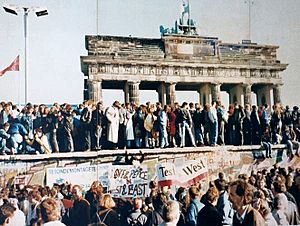
Unrest and the eventual fall of communism also happened in Yugoslavia. But the reasons were different from the Warsaw Pact countries. The death of Josip Broz Tito in 1980 left a power vacuum. This allowed the rise of rival ethnic nationalism in the country, which had many different nationalities. The first leader to use nationalism for political reasons was Slobodan Milošević. He used Serbian nationalism to become president of Serbia and demanded special treatment for Serbia and Serbs. This led to a rise in Slovene and Croat nationalism. The League of Communists of Yugoslavia collapsed in 1990. Nationalists won multi-party elections in most of Yugoslavia's republics. This eventually led to civil war among the different nationalities starting in 1991. Yugoslavia broke apart in 1992.
The Soviet Union itself collapsed between 1990 and 1991. This was due to rising nationalism and a power struggle between Gorbachev and Boris Yeltsin, the new leader of the Russian Federation. The collapse was also helped by pressure from capitalist countries, loans from world banks, and demands for democracy and more consumer goods within the Soviet Bloc. U.S. economic policies made it very hard for the Soviet Union to borrow money. As the Soviet Union was collapsing, Gorbachev prepared the country to become a loose group of independent states called the Commonwealth of Independent States. Hardline communist leaders in the military reacted to Gorbachev's policies with the August Coup of 1991. They overthrew Gorbachev and took control of the government. This government lasted only a short time as widespread public protests erupted. Gorbachev was returned to power, but the different Soviet republics were now set for independence. On December 25, 1991, Gorbachev officially announced the end of the Soviet Union. This ended the world's first communist state.
Communism Today (1993–Present)
With the fall of communist governments in the Soviet Union and Eastern Europe, the influence of state-based Marxist–Leninist ideas weakened. However, there are still many communist movements of different types and sizes around the world. Three other communist nations, especially in East Asia like China, Vietnam, and Laos, moved towards market economies. But they did so without much privatization of state-owned businesses during the 1980s and 1990s.
Cuba has recently recovered from a difficult time caused by the fall of the Soviet Union. This is thanks to more trade with new allies like Venezuela and China. Venezuela has adopted a "socialism of the 21st century" according to Hugo Chávez. Many other countries in Latin America and the Caribbean have also moved towards more socialist policies and ideas. This is sometimes called the "pink tide."
North Korea says its success in avoiding the fall of socialism is because of its own idea called Juche. It adopted this in the 1970s, replacing Marxism–Leninism. Cuba has an ambassador to North Korea. China still protects North Korea's borders, even though it doesn't provide much material help.
In Nepal, the Communist Party of Nepal (Unified Marxist–Leninist) leader Man Mohan Adhikari was briefly Prime Minister of Nepal from 1994 to 1995. The Maoist guerrilla leader Prachanda was elected prime minister in 2008. Prachanda has since been removed as prime minister. This led the Maoists to go back to street protests and activism. They lead occasional general strikes, using their strong influence on the Nepalese labor movement. Since 2008, Nepal has been ruled by a group of communist parties. They merged in 2018 to form the Nepal Communist Party.
The previous government of India relied on support from the Communist Party of India (Marxist) and Communist Party of India. Currently, the CPI(M) and CPI lead the state government in Kerala. The armed group of the Communist Party of India (Maoist), the People's Liberation Guerrilla Army, is fighting an insurgency against the Indian government in some parts of the country.
In Cyprus, the long-time communist Dimitris Christofias of AKEL won the 2008 presidential election. He became the first and only communist head of state in a European Union country.
In Ukraine and Russia, communist parties came in second place in elections in the early 2000s. The Communist Party of the Russian Federation is still strong in Russia. However, the Communist Party of Ukraine lost its seats in parliament in 2014 after the Russian invasion of Ukraine. The party has been banned since 2015.
In the Czech Republic, the Communist Party of Bohemia and Moravia came third in the 2002 elections. The Portuguese Communist Party also came third in 2005.
In South Africa, the South African Communist Party (SACP) is part of an alliance with the African National Congress and the Congress of South African Trade Unions. Sri Lanka has communist ministers in its national government.
In Zimbabwe, former president Robert Mugabe of the Zimbabwe African National Union – Patriotic Front said he was a communist.
Colombia has been in a civil war since 1966. The Colombian government and right-wing groups are fighting against two communist guerrilla groups: the Revolutionary Armed Forces of Colombia–People's Army (FARC–EP) and the National Liberation Army (ELN).
The Revolutionary Communist Party, USA is currently working for a revolution in the United States. They want to overthrow the capitalist system and replace it with a socialist state.
In the early 2020s, the Philippines is still experiencing a small-scale guerrilla insurgency by the New People's Army. This is the armed group of the outlawed Communist Party of the Philippines.
|
See also
 In Spanish: Historia del comunismo para niños
In Spanish: Historia del comunismo para niños
- Foreign relations of China
- Foreign relations of Cuba
- Foreign relations of Laos
- Foreign relations of North Korea
- Foreign relations of the Soviet Union
- Foreign relations of Vietnam


